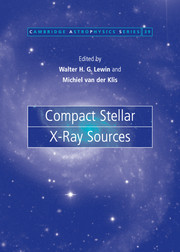Book contents
- Frontmatter
- Contents
- List of contributors
- Preface
- 1 Accreting neutron stars and black holes: a decade of discoveries
- 2 Rapid X-ray variability
- 3 New views of thermonuclear bursts
- 4 Black hole binaries
- 5 Optical, ultraviolet and infrared observations of X-ray binaries
- 6 Fast X-ray transients and X-ray flashes
- 7 Isolated neutron stars
- 8 Globular cluster X-ray sources
- 9 Jets from X-ray binaries
- 10 X-rays from cataclysmic variables
- 11 Super-soft sources
- 12 Compact steller X-ray sources in normal galaxies
- 13 Accretion in compact binaries
- 14 Soft gamma repeaters and anomalous X-ray pulsars: magnetar candidates
- 15 Cosmic gamma-ray bursts, their afterglows, and their host galaxies
- 16 Formation and evolution of compact stellar X-ray sources
- Author index
- Subject index
7 - Isolated neutron stars
Published online by Cambridge University Press: 01 September 2009
- Frontmatter
- Contents
- List of contributors
- Preface
- 1 Accreting neutron stars and black holes: a decade of discoveries
- 2 Rapid X-ray variability
- 3 New views of thermonuclear bursts
- 4 Black hole binaries
- 5 Optical, ultraviolet and infrared observations of X-ray binaries
- 6 Fast X-ray transients and X-ray flashes
- 7 Isolated neutron stars
- 8 Globular cluster X-ray sources
- 9 Jets from X-ray binaries
- 10 X-rays from cataclysmic variables
- 11 Super-soft sources
- 12 Compact steller X-ray sources in normal galaxies
- 13 Accretion in compact binaries
- 14 Soft gamma repeaters and anomalous X-ray pulsars: magnetar candidates
- 15 Cosmic gamma-ray bursts, their afterglows, and their host galaxies
- 16 Formation and evolution of compact stellar X-ray sources
- Author index
- Subject index
Summary
Introduction
This chapter deals with X-ray emission from isolated neutron stars for which the energy for the observed X-rays is thought to originate from the rotation of the neutron star, or from an internal heat reservoir following formation. Rotation power can manifest itself as pulsed emission, or as nebular radiation produced by a relativistic wind of particles emitted by the neutron star. Residual heat of formation is observed as soft X-ray emission from young neutron stars. Such thermal radiation, however, can also be produced as a result of reheating from internal or external sources. Rotation-powered pulsed and nebular X-ray emission, as well as thermal emission, can often be observed in a single object simultaneously; this is both fascinating and annoying, as one invariably contaminates the study of the other. There are also a handful of neutron stars for which the origin of the observed X-ray emission is unclear but may be related to the above processes; we will discuss those as well.
Rotation-powered neutron stars are generally referred to as “radio pulsars” since it is at radio wavelengths that the vast majority of the catalogued population (currently numbering ∼1400) is observed. However, the radio emission is energetically unimportant, and we now know of several rotation-powered neutron stars that are not detected as radio sources in spite of deep searches (e.g. Crawford et al. 1998; McLaughlin et al. 2001). We therefore use the more physically motivated term “rotation-powered.”
- Type
- Chapter
- Information
- Compact Stellar X-ray Sources , pp. 279 - 340Publisher: Cambridge University PressPrint publication year: 2006
- 66
- Cited by



